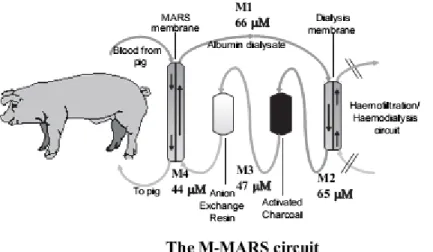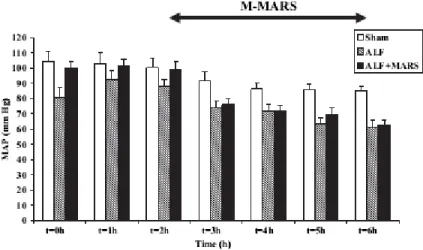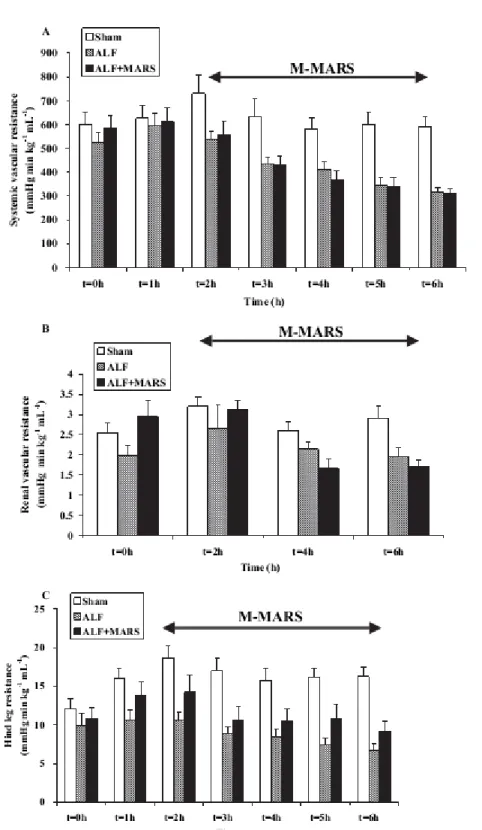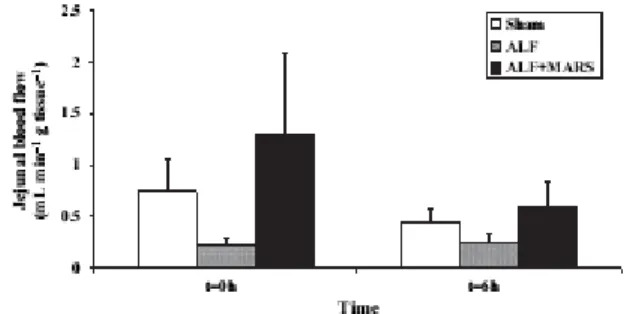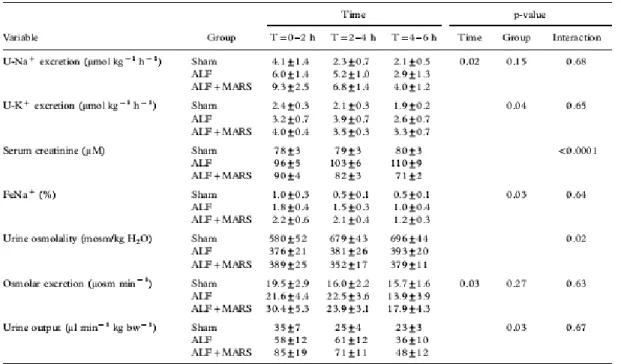S
YSTEMIC AND REGIONAL HAEMODYNAMICS IN PIGS
WITH ACUTE LIVER FAILURE AND THE EFFECT OF
ALBUMIN DIALYSIS
Lars M. Ytrebø1,3, Sambit Sen3, Christopher Rose4, Nathan A. Davies3, Geir I.
Nedredal1, Ole-Martin Fuskevaag2, Gabrie A. M. Ten Have5, Frits W. Prinzen6,
Roger Williams3, Nicolaas E. P. Deutz5, Rajiv Jalan3† and Arthur Revhaug1
1Departments of Digestive Surgery, 2Clinical Pharmacology, University Hospital Northern Norway, Tromsø, Norway 3The UCL Institute of Hepatology, University College London, London, UK 4Department of Cellular Neuroscience, Max-Delbrück Center for Molecular Medicine, Berlin, Germany 5Department of Surgery, Maastricht University, Maastricht, The Netherlands 6Cardiovascular Research Institute Maastricht, Maastricht University, Maastricht, The Netherlands †Correspondence: Rajiv Jalan, Liver Failure Group, Institute of Hepatology, University College London, 69–75 Chenies Mews, London, WC1E 6HX, UK, +44 (0) 207 6796 550, +44 (0) 207 3800 405 r.jalan@ucl.ac.uk
A
BSTRACT
Objective. Acute liver failure (ALF) is haemodynamically characterized by a hyperdynamic circulation. The aims of this study were to investigate the systemic and regional haemodynamics in ALF, to measure changes in nitric oxide metabolites (NOx) and to evaluate whether these haemodynamic disturbances could be attenuated with albumin dialysis. Material and methods. Norwegian Landrace pigs (23–30 kg) were randomly allocated to groups as controls (sham-operation, n=8), ALF (hepatic devascularization, n=8) and ALF + albumin dialysis (n=8). Albumin dialysis was started 2 h after ALF induction and continued for 4 h. Systemic and regional haemodynamics were monitored. Creatinine clearance, nitrite/nitrate and catecholamines were measured. A repeated measures ANOVA was used to analyse the data. Results. In the ALF group, the cardiac index increased (PGT<0.0001), while mean arterial pressure (PG=0.02) and systemic vascular resistance decreased (PGT<0.0001). Renal resistance (PG=0.04) and hind-leg resistance (PGT=0.003) decreased in ALF. There was no difference in jejunal blood flow between the groups. ALF pigs developed renal dysfunction with increased serum creatinine (PGT=0.002) and decreased creatinine clearance (P=0.02). Catecholamines were significantly higher in ALF, but NOx levels were not different. Albumin dialysis did not attenuate these haemodynamic or renal disturbances. Conclusions. The haemodynamic disturbances during the early phase of ALF are characterized by progressive systemic vasodilatation with no associated changes in
metabolites of NO. Renal vascular resistance decreased and renal dysfunction developed independently of changes in renal blood flow. After 4 h of albumin dialysis there was no attenuation of the haemodynamic or renal disturbances. Keywords: Albumin dialysis, artificial organs, hepatorenal syndrome, hyperdynamic circulation
I
NTRODUCTION
Acute liver failure (ALF) is haemodynamically characterized by hyperdynamic circulation with high cardiac output, low mean arterial pressure (MAP) and low systemic vascular resistance (SVR) [1], [2]. This reduction in MAP often requires inotropic intervention, which is a bad prognostic sign. These circulatory disturbances are thought to underlie the development of renal dysfunction, and a proportion of patients with ALF will become dependent upon some form of renal support. These derangements are reversible with liver transplantation, suggesting that they are consequent upon liver dysfunction. The pathophysiologic mechanisms underlying these disturbances are unclear but increased nitric oxide (NO) production and cGMP has been demonstrated during the later stages of the disease [1],
The molecular adsorbents recirculating system (MARS) is an albumin dialysis system that is capable of removing protein-bound substances from the circulation [4–7]. This system has formerly been shown to improve systemic haemodynamic variables in patients with hyperacute liver failure and also in patients with cirrhosis [8], [9]. Furthermore, preliminary data suggest that MARS may be of benefit in improving renal function in patients with advanced cirrhosis and type I hepatorenal syndrome [10]. The mechanisms by which MARS achieves these beneficial effects on haemodynamic and renal function in cirrhosis are not clear but are thought to be through a reduction in NO levels [11].
We have previously described a large animal (porcine) model of ALF, induced by hepatic devascularization, which is associated with typical clinical and biochemical features of ALF [12–15]. The animals have a sharp increase in bilirubin, aminotransferases, prothrombin time and progressive reduction in MAP and SVR, with renal dysfunction and intracranial hypertension. The aims of the present study were to find answers to three questions relating to the early phase of haemodynamic disturbances in ALF: 1) Is the progressive reduction in SVR and MAP due to a
generalized vasodilation or limited to the splanchnic region only? 2) Is this hyperdynamic circulation associated with an increase in the metabolites of NO and associated neurohumoral activation? 3) Can albumin dialysis attenuate the development of these haemodynamic and renal disturbances?
M
ATERIAL AND METHODS
Study outline
The Norwegian Experimental Animal Board approved the present study. Twenty-four female Norwegian Landrace pigs (23–30 kg) were randomly allocated into three groups by opening sealed, pre-numbered envelopes: Sham, ALF or ALF + albumin dialysis groups. T = 0 h was defined as the time of hepatic artery ligation (ALF) or completion of abdominal surgery (sham). Albumin dialysis was started 2 h after hepatic devascularization and continued for 4 h, after which the experiments were terminated by administering an overdose of pentobarbital and potassium chloride.
Animal preparation
The pigs were kept in the animal department for 2 days before the experiments. Details regarding the animal room facilities, anaesthesia and surgical preparation have been reported previously [12–14]. ALF was induced by an end-to-side portacaval shunt, along with ligation of the hepatic arteries. The abdomen was closed after completion of the surgical procedures. All animals received 500 ml 0.9% NaCl containing 625 mg glucose as a preoperative load. During the experiment, 0.9% NaCl was infused at a rate of 3 ml/kg/h. After ALF induction, 50% glucose and 20% human albumin (Octapharm, Hurdal, Norway) were continuously infused at rates of 0.6048 ml/kg/h and 0.66 ml/kg/h, respectively. However, sham-operated animals received only half the amount of glucose (0.3024 ml/kg/h) in order to render the glucose levels comparable between the groups.
For ethical reasons it would not have been possible to carry out our study without a differentiated anaesthesia protocol. Sham-operated animals received continuous anaesthesia during the experimental period. Anaesthesia was stopped after the liver was devascularized, but ALF pigs received fentanyl and midazolam if there were clinical signs of light sedation after completion of the liver devascularization procedure. Furthermore, the M-MARS-treated animals needed higher doses than the ALF group because of the removal of these substances by the M-MARS device [4]. Accordingly, administration of anaesthesia in the ALF groups was performed under close clinical monitoring, in order to keep the animals sedated and free of pain during the experimental period. All animals received equal amounts of intravenous fluids during the experiments. Further details regarding anaesthesia and ventilator settings have recently been reported [4]. Briefly, the pigs underwent a tracheotomy, and were intubated and ventilated (FiO2=0.5) on a volume-controlled respirator (Servo 900; Elema-Schönander, Stockholm, Sweden). Tidal volume
was adjusted by means of repeated arterial blood gas analyses to maintain PaCO2 levels at between 4.5 and 5.0 kPa during surgery. Ventilation was not altered after t = 0 h. Core body temperature was maintained normothermic at 38.5±1°C with a heating pad and blankets (normal temperature for pigs).
Positioning of catheters and measurements
A 5-French Edwards Swan-Ganz catheter (Baxter Healthcare Corp., Irvine, Calif., USA) was floated into the pulmonary artery via the right external jugular vein. Cardiac output was measured in triplicate and the results expressed as the mean value (Vigilance; Edwards Lifesciences, Irvine, Calif., USA).
A 16-G central venous catheter (Secalon T; Ohmeda, Swindon, UK) was inserted into the left external jugular vein for administration of drugs and fluids. We used a primed, continuous infusion of para-aminohippuric acid (PAH) (A1422; Sigma Chemical Co., St. Louis, Mo., USA) to measure renal plasma flow at t = 0 h and t = 6 h. MAP was measured in the abdominal aorta through a direct puncture catheter [16], [17]. Arterial blood samples were drawn from another thin catheter in the abdominal aorta. Albumin dialysis was performed through an 11.5 Fr dual lumen catheter (Mahurkar; Tyco Healthcare, UK) inserted in the inferior vena cava. Similar catheters were inserted in the shams and ALF animals as well. The urinary bladder was drained via a cystotomy.
Renal and jejunal blood flow were determined using the fluorescent microsphere method [18]. Iliac artery blood flow, portal vein blood flow and portacaval shunt blood flow were continuously measured with perivascular flow probes (CardioMed Systems, Medistim A/S, Oslo, Norway).
Biochemical analyses
Arterial and venous blood samples were drawn into vacutainers (4 ml) at t = 0 h, t = 2 h, t = 4 h and t = 6 h. Samples were placed on ice and centrifuged at 4°C at 8500g for 5 min, and subsequently frozen at −80°C for later analyses. PAH was determined spectrophotometrically after deacetylation of the supernatant fluid at 100°C for 45 min[19]. Noradrenaline and adrenaline concentrations in urine were measured as previously described [20]. Nitrite and nitrate (NOx) were determined by a modified Greiss test [21]. The NOx in the filtrate was determined utilizing methods described by Miranda et al. [22]. Nitrite was determined using a chemiluminescence apparatus (Sievers 280 NOA, Boulder, Colo., USA) according to established techniques [23].
Sodium, potassium, creatinine and urine osmolality were analysed using routine methods at the Department of Clinical Chemistry.
Use of modified MARS (M-MARS)
MARS (Teraklin AG, Rostock, Germany) (Figure 1) is an extracorporeal system utilizing a hollow fibre dialysis module to dialyse blood across an albumin-impregnated polysulphone membrane (cut-off 50 kDa) against 20% albumin as dialysate in the extra-capillary compartment [7], [24], [25]. As the present study was designed specifically to evaluate the role of albumin dialysis in ALF, haemofiltration/dialysis was not performed (i.e. no removal of free water or water-soluble toxins), and the relevant parts of the circuit were clamped off and hence referred to as modified-MARS (M-MARS) [4].
Figure 1. The modified molecular adsorbent recirculating system (M-MARS) set-up. Haemofiltration/haemodialysis unit clamped off. M1, M2, M3 and M4 indicate the sampling sites from which the dialysate samples were drawn for creatinine measurements at t = 6 h.
Calculations
Renal and jejunal blood flow (Q, ml min−1 g−1) were calculated as:
where Qref is the withdrawal speed of the arterial reference sample (in ml/min), Ii and Iref are the fluorescence intensities in sample i and the reference sample, respectively, and Gi is the weight of the tissue sample.
Renal plasma flow (ml min−1 kg body-weight−1) was calculated as:
Renal vascular resistance, renal perfusion pressure, pulmonary vascular resistance, systemic vascular resistance index and vascular resistance across the hind leg were calculated in accordance with standard formulas. Body-weight was used to calculate all indexes.
Creatinine clearance was calculated by using the standard clearance equation: where x denotes creatinine.
Fractional sodium excretion was calculated as:
where u-Na and s-Na are the sodium concentrations in urine and serum, respectively. S-Cr and u-Cr denote the concentrations of creatinine in serum and urine, respectively. Plasma osmolality was calculated from the serum levels of the following osmoles:
Statistical analysis
Statistical analysis was performed using the Statistical Package for the Social Sciences, version 12.0 for Windows (SPSS, Chicago, Ill., USA). Data are expressed as mean values and SEM. Distributions of data were examined before applying parametric statistics. Two-way ANOVA was applied to test for differences within and between groups over time. An overall significance in analyses of variance for repeated measurements (F-test p≤0.05) may be attributable to either the effect of group (PG) or the interaction for group and time (PGT). Overall significance for the effect of group means that the groups were different when all the repeated measurements were taken together (irrespective of time), while a significant interaction denotes a different time course in the two groups. PT≤0.05 denotes a significant change during the experimental period, but without any difference between the groups.
Greenhouse-Geisser epsilon factor adjusted probability levels were always used when Mauchly's test was significant. A p-value ≤ 0.05 was considered significant for all tests applied.
R
ESULTS
Two pigs (one sham and one ALF) were excluded from the statistical analysis owing to localized intracranial haemorrhage found at post-mortem. No other complications were noted at post-mortem examination in any of the other pigs.
Systemic and regional haemodynamics
ALF versus sham. Pigs with ALF developed a hyperdynamic circulation. Cardiac index increased (PGT<0.0001), while
MAP (PG=0.02) and SVRI decreased significantly (PGT<0.0001) (Figure 2, Figure 3A, Table I).
Figure 2. Mean arterial pressure (MAP) decreased in pigs with acute liver failure (ALF) and was significantly lower compared with that in shams (PG=0.02). Albumin dialysis did not attenuate this derangement. Mean±SEM.
Hind-leg blood flow (Table I) did not change in the ALF group, while it initially decreased and remained lower in the sham group (PG=0.03). Vascular resistance across the hind leg increased in shams, whereas it decreased slightly in ALF (PGT<0.003) (Figure 3C). No difference was found in renal blood flow between ALF and sham animals
(PG=0.44), nor was there any difference in renal plasma flow (Figure 6) between ALF and sham animals (PGT=0.31). Renal perfusion pressure dropped to 56±4 mmHg in ALF pigs compared to 80±3 mmHg in the sham group
(PGT=0.02). Renal vascular resistance increased in shams, while it remained unchanged in the ALF group
(PGT=0.04) (Figure 3B). There was no difference in jejunal blood flow between the sham and ALF groups after 6 h (p=0.56) (Figure 4). Hb decreased significantly during the course of the study in the ALF (8.2±0.2 to 6.4±0.3 g/dl) and ALF + M-MARS (8.5±0.2 to 6.1±0.4 g/dl) groups (p<0.01, respectively), while this decrease did not reach significance in sham-operated animals (8.2±0.4 to 7.6±0.2 g/dl).
ALF + M-MARS versus ALF. Albumin dialysis did not alter any of the systemic or regional haemodynamic variables
Figure 3. Systemic vascular resistance decreased significantly (PGT<0.0001) in acute liver failure (ALF) compared to shams. Albumin dialysis did not attenuate this derangement. Mean±SEM. Renal vascular resistance increased in shams, while it remained unchanged in the ALF group (PGT=0.04). Albumin dialysis did not attenuate this
derangement. Mean ±SEM. Vascular resistance across the hind leg increased in shams, while it slightly decreased in ALF (PGT=0.003). Albumin dialysis did not attenuate this derangement. Mean±SEM.
Table I. Systemic and regional haemodynamic data.
Figure 4. No difference in jejunal blood flow between the groups at t = 6 h. Mean±SEM.
Renal function
ALF versus sham. Serum creatinine (Table IV) increased (PGT=0.002) and creatinine clearance (p=0.02) decreased
(Figure 5) in the ALF group. Urine output was not significantly different between the groups.
Figure 5. Creatinine clearance decreased in pigs with acute liver failure (ALF) and was significantly lower in the time period t = 4–6 h (p=0.02). Albumin dialysis did not improve renal function in this model. Mean±SEM.
Figure 6. No difference in renal plasma flow between the acute liver failure (ALF) and sham groups during the experimental period (PGT=0.31). Albumin dialysis did not alter renal plasma flow. Mean±SEM.
Urinary sodium excretion decreased in both groups (p=0.02) without any difference between groups. Fractional sodium excretion (FeNa) decreased in both groups during the experimental period, but the groups were not different. Serum potassium was increased in ALF animals (data not shown), which we found was correlated to increased potassium excretion in ALF pigs compared to shams (PG=0.04). Urine osmolality increased in shams, but remained unchanged in the ALF animals (PGT=0.02) (Table II). However, osmolar excretion was not different at any time-point.
Table II. Urinary excretions of adrenaline and noradrenaline were significantly higher in the ALF group compared to the sham group. The albumin dialysis group did not differ from the ALF group.
ALF + M-MARS versus ALF. Serum creatinine decreased in the ALF + M-MARS group (PGT<0.0001). Creatinine
clearance decreased in the ALF + M-MARS group and was not different from the ALF group at t = 6 h (Figure 5). However, creatinine was measured in the M-MARS circuit as well and the results show that the M-MARS system took off creatinine from the systemic circulation. Creatinine levels in the various segments of the M-MARS circuit at t = 6 h are depicted in Figure 1.
No difference was found in urine output from ALF pigs at any time-point. Assessment of tubular function (sodium excretion, fractional sodium excretion) and the ability of the kidneys to concentrate urine did not reveal any difference between the groups (Table IV).
NO and catecholamines
Noradrenaline and adrenaline excretions in urine (Table II) were significantly higher in the ALF group compared with the sham group (PG=0.003 and PG<0.0001, respectively). No difference was found in NOx and NO2
concentrations (Table III) between the sham and ALF groups or between the ALF and ALF + M-MARS groups at t = 6 h. Table III. Arterial plasma levels of NOx (nitrate and nitrite) and NO2 (nitrite). No significant differences between sham and ALF at t = 6 h.
In this porcine model of ALF, our results reflect typical cardiovascular features of ALF characterized by a progressive reduction in MAP and SVRI. However, this vasodilation was not limited to the splanchnic area, as the kidneys and hind-leg muscles were also affected. We also demonstrated evidence of renal dysfunction in this model, which occurred independently of changes in renal blood flow. Furthermore, we showed that this generalized vasodilation with consequent reduction in MAP was associated with activation of the neurohumoral system, indicated by an increase in the catecholamines but not with any significant changes in nitrates or nitrites. Finally, 4 h of therapy with MARS did not attenuate these circulatory and renal disturbances.
The data from the present study confirm those from our previous observations of significant haemodynamic disturbances in ALF characterized by increased cardiac output and decreased MAP and SVRI [12], [14]. The most important observation in our study was that we found a reduction in the vascular resistance of the kidneys and hind leg, which accompanied the reduction in SVRI. Furthermore, there was no difference in jejunal blood flow between the sham and ALF groups at t = 6 h. Although we were unable to calculate vascular resistance across the gut, jejunal blood flow and MAP data are suggestive of a significant reduction of vascular resistance across the jejunum in ALF compared with sham-operated controls. Taken together, this is in contrast to that observed in cirrhosis and suggests that extrapolation of pathophysiologic mechanisms and therapy from cirrhosis to ALF is unlikely to be correct. However, this observation suggesting that there is no splanchnic vasodilation in ALF must be viewed with some caution as we describe changes in jejunal blood flow using the microsphere technique in a model where ALF has been induced by the surgical procedure, portacaval shunting.
Activation of the neurohumoral system is likely to represent a compensatory response to the observed vasodilation. Decreased effective circulatory volume is also known to activate the neurohumoral system, which results in
increased catecholamine levels. However, the mechanisms of this “generalized” systemic vasodilation remain unclear. There is substantial evidence in cirrhosis to show that NO is important and increased cGMP has been observed in ALF [1], [3]. The lack of any significant change in metabolites of NO during the development of these circulatory abnormalities support the view that NO is not an important initiating mechanism in the development of the hyperdynamic circulation in ALF. However, before we can dismiss the NO hypothesis as an initiating factor for the observed haemodynamic disturbances, further studies involving measurement of the rate of NO production and use of specific NO inhibitors are necessary.
To date, renal dysfunction in ALF has been thought to be associated with severe renal vasoconstriction and
significant reduction in renal blood flow [26–28]. This notion has been attributed to two experimental studies [27], [28]. These studies were performed in a galactosamine rat model, in which decreased renal blood flow and increased renal vascular resistance were demonstrated 48 h after ALF induction. Although there were signs of decreased renal function before t = 48 h, decreased creatinine clearance was only discussed in relation to the findings of increased renal vascular resistance and decreased renal blood flow. The seemingly contradictory results between our observations and those reported previously may relate to the timing of the measurements, the use of resuscitation and the type of model used. Our studies explored an early phase of renal dysfunction following ALF induction, while the other studies focused on renal haemodynamics and function at a later stage. An alternative explanation is the potential effect of resuscitation. Our animals were resuscitated, while the rats in the other two studies were not. This fact might explain the differences in systemic and regional haemodynamics. Finally, in the previous studies, ALF was induced by galactosamine, which is known to induce bacterial translocation, portal endotoxaemia and significant portosystemic shunting [27], [29], [30]. Accordingly, the circulatory derangements observed in galactosamine-induced ALF models are likely to be different from devascularized ALF models. In the present study there was no evidence of inflammation [31]. This discrepancy between the models is important and might have contributed significantly to the differences observed. If our observations are put in the context of the data in the literature, it is
possible that these studies describe two different stages of the disease; generalized vasodilation in the initial stage and vasoconstriction of the regional vascular beds in the later stages possibly due to the effect of activation of the neurohormonal system. This hypothesis will need to be tested in future studies.
Furthermore, our data indicate that the pathophysiological basis of renal dysfunction in this model of ALF is different from hepatorenal syndrome (HRS) seen in patients with chronic liver failure. We found a significant reduction in creatinine clearance indicating a reduction in glomerular filtration rate (GFR), despite no change in renal plasma flow (RPF). There was no biochemical evidence of an acute tubular dysfunction in pigs with ALF. Although the urine osmolality was lower, osmolal excretion was not significantly different from shams, owing to differences in urine output. As GFR is the product of RPF and the filtration fraction, a decrease in GFR must have been caused by a decreased glomerular filtration fraction. Filtration fraction is determined by the filtration coefficient and glomerular filtration pressure [32]. Unfortunately, our data did not allow us to explore these mechanisms in greater detail. The results of our study showing no significant effects of M-MARS on the systemic haemodynamics and renal function are at variance with the previous observations in patients with ALF. In an open, non-randomized study of eight patients with hyperacute ALF caused by paracetamol intoxication or hepatitis B infection [9], MARS was found to increase MAP and decrease CI. However, the improvement in systemic haemodynamics with MARS is not a universal phenomenon, and in a recently published study on patients with acute-on-chronic liver failure, we were not able to observe any significant improvements in systemic haemodynamics or renal function with MARS [11]. It is possible that the lack of any observed effect of MARS on the systemic haemodynamic variables in the present study may be related to the relatively short duration of treatment. Although the present model is associated with typical clinical and biochemical features of ALF [12–15], liver ischaemia is not a common aetiology for ALF [33], [34] and the animals were studied within a rather short time frame. These facts should be borne in mind when data are
interpreted.
In summary, the results of this study show that the progressive systemic vasodilation in ALF is generalized and not limited to the splanchnic area and that these haemodynamic changes are not accompanied by an increase in NO metabolites. The renal dysfunction of ALF is an early phenomenon and occurs independently of changes in RPF and is probably due to alternations in GFR. Future studies should address the factors initiating the vascular and renal disturbances in ALF.
A
KNOWLODGEMENTS
We express our gratitude to Drs. Joar Julsrud and Eigil Nygård for invaluable comments on the manuscript. The study was supported by the Norwegian Research Council, the Sir Siegmund Warburg Voluntary Settlement, the Mason Medical Foundation, the Liver Research Foundation and Maastricht University. Teraklin provided the MARS kits and travel costs for the investigators.
R
EFERENCES
Ellis A, Wendon J. Circulatory, respiratory, cerebral, and renal derangements in acute liver failure: pathophysiology and management. Semin Liver Dis 1996; 16: 379–88
Trewby PN, Williams R. Pathophysiology of hypotension in patients with fulminant hepatic failure. Gut 1977; 18: 1021–6 Schneider F, Lutun P, Boudjema K, Wolf P, Tempe JD. In vivo evidence of enhanced guanylyl cyclase activation during the hyperdynamic circulation of acute liver failure. Hepatology 1994; 19: 38–44
Stange J, Mitzner S, Ramlow W, Gliesche T, Hickstein H, Schmidt R. A new procedure for the removal of protein-bound drugs and toxins. Asaio J 1993; 39: M621–5
Stange J, Ramlow W, Mitzner S, Schmidt R, Klinkmann H. Dialysis against a recycled albumin solution enables the removal of albumin-bound toxins. Artif Organs 1993; 17: 809–13
Sorkine P, Ben Abraham R, Szold O, Biderman P, Kidron A, Merchav H, et al. Role of the molecular adsorbent recycling system (MARS) in the treatment of patients with acute exacerbation of chronic liver failure. Crit Care Med 2001; 29: 1332–6
Schmidt LE, Wang LP, Hansen BA, Larsen FS. Systemic hemodynamic effects of treatment with the molecular adsorbents recirculating system in patients with hyperacute liver failure: a prospective controlled trial. Liver Transpl 2003; 9: 290–7 Mitzner SR, Stange J, Klammt S, Risler T, Erley CM, Bader BD, et al. Improvement of hepatorenal syndrome with extracorporeal albumin dialysis MARS: results of a prospective, randomized, controlled clinical trial. Liver Transpl 2000; 6: 277–86
Sen S, Davies NA, Mookerjee RP, Cheshire LM, Hodges SJ, Williams R, et al. Pathophysiological effects of albumin dialysis in acute-on-chronic liver failure: A randomized controlled study. Liver Transpl 2004; 10: 1109–19
Ytrebø LM, Nedredal GI, Langbakk B, Revhaug A. An experimental large animal model for the assessment of bioartificial liver support systems in fulminant hepatic failure. Scand J Gastroenterol 2002; 37: 1077–88
Ytrebø LM, Ingebrigtsen T, Nedredal GI, Elvenes OP, Korvald C, Romner B, et al. Protein S-100beta: a biochemical marker for increased intracranial pressure in pigs with acute hepatic failure. Scand J Gastroenterol 2000; 35: 546–51
Ytrebø LM, Korvald C, Nedredal GI, Elvenes OP, Nielsen Grymyr OJ, Revhaug A. N-acetylcysteine increases cerebral perfusion pressure in pigs with fulminant hepatic failure. Crit Care Med 2001; 29: 1989–95
Ytrebø LM, Nedredal GI, Korvald C, Holm Nielsen OJ, Ingebrigtsen T, Romner B, et al. Renal elimination of protein S-100beta in pigs with acute encephalopathy. Scand J Clin Lab Invest 2001; 61: 217–25
Hallemeesch MM, Ten Have GA, Deutz NE. Metabolic flux measurements across portal drained viscera, liver, kidney and hindquarter in mice. Lab Anim 2001; 35: 101–10
Ten Have GA, Bost MC, Suyk-Wierts JC, van den Bogaard AE, Deutz NE. Simultaneous measurement of metabolic flux in portally-drained viscera, liver, spleen, kidney and hindquarter in the conscious pig. Lab Anim 1996; 30: 347–58
Van Oosterhout MF, Willigers HM, Reneman RS, Prinzen FW. Fluorescent microspheres to measure organ perfusion: validation of a simplified sample processing technique. Am J Physiol 1995; 269: H725–33
Deutz NE, Reijven PL, Bost MC, van Berlo CL, Soeters PB. Modification of the effects of blood on amino acid metabolism by intravenous isoleucine. Gastroenterology 1991; 101: 1613–20
Kushnir MM, Urry FM, Frank EL, Roberts WL, Shushan B. Analysis of catecholamines in urine by positive-ion electrospray tandem mass spectrometry. Clin Chem 2002; 48: 323–31
Giovannoni G, Land JM, Keir G, Thompson EJ, Heales SJ. Adaptation of the nitrate reductase and Griess reaction methods for the measurement of serum nitrate plus nitrite levels. Ann Clin Biochem 1997; 34: 193–8
Miranda KM, Espey MG, Wink DA. A rapid, simple spectrophotometric method for simultaneous detection of nitrate and nitrite. Nitric Oxide 2001; 5: 62–71
Marley R, Feelisch M, Holt S, Moore K. A chemiluminescence-based assay for S-nitrosoalbumin and other plasma S-nitrosothiols. Free Radic Res 2000; 32: 1–9
Jalan R, Sen S, Steiner C, Kapoor D, Alisa A, Williams R. Extracorporeal liver support with molecular adsorbents recirculating system in patients with severe acute alcoholic hepatitis. J Hepatol 2003; 38: 24–31
Stange J, Mitzner S. A carrier-mediated transport of toxins in a hybrid membrane. Safety barrier between a patient's blood and a bioartificial liver. Int J Artif Organs 1996; 19: 677–91
Gines P, Guevara M, Arroyo V, Rodes J. Hepatorenal syndrome. Lancet 2003; 362: 1819–27
Javle P, Yates J, Kynaston HG, Parsons KF, Jenkins SA. Hepatosplanchnic haemodynamics and renal blood flow and function in rats with liver failure. Gut 1998; 43: 272–9
Anand R, Harry D, Holt S, Milner P, Dashwood M, Goodier D, et al. Endothelin is an important determinant of renal function in a rat model of acute liver and renal failure. Gut 2002; 50: 111–7
Kasravi FB, Wang L, Wang XD, Molin G, Bengmark S, Jeppsson B. Bacterial translocation in acute liver injury induced by D-galactosamine. Hepatology 1996; 23: 97–103
Rahman TM, Hodgson HJ. Animal models of acute hepatic failure. Int J Exp Pathol 2000; 81: 145–57
Sen S, Rose C, Ytrebø LM, Davies NA, Nedredal GI, Drevland SS, Kjonno M, et al. Albumin dialysis reduces brain water and intracranial pressure in acute liver failure: a randomised controlled study in a pig model. Hepatology 2003; 38 Suppl 1: 540A Rose BD, Post TW. Clinical physiology of acid-base and electrolyte disorders. 5th ed. New York: McGraw-Hill; 2001. X: 992 pp. Polson J, Lee WM. AASLD position paper: the management of acute liver failure. Hepatology 2005; 41: 1179–97
